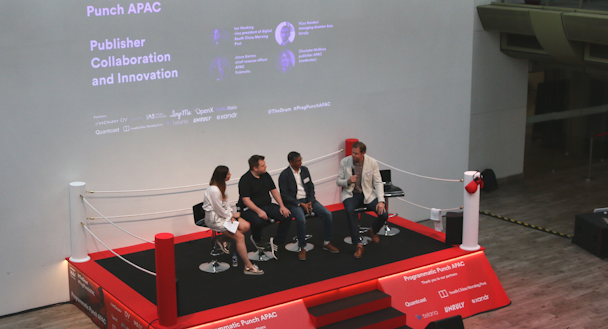Identity poses an ongoing threat towards publishers: Programmatic Punch APAC 2019
At The Drum’s Programmatic Punch APAC, experts from the South China Morning Post, PubMatic and Unruly dive into the new types of innovations and collaboration that should solve the issues publishers have been facing in putting their prized inventory onto programmatic.

Identity poses an ongoing threat towards publishers: Programmatic Punch APAC 2019
Jason Barnes, chief revenue officer, APAC, PubMatic, notes that the list of issues is extensive, with problems around mobile being high on the agenda.
Issues around mobile and identity
Compared to a traditional publisher which had print or broadcast for revenue streams, digital has changed the playing field. “Publishers find it really difficult to make the same revenue in digital as it did from broadcast or print… They're just not making the revenue on digital that they used to.”
With the consumer migration to mobile, specifically through to the app, there's been even less ability for publishers to be able to monetize their inventory, added Barnes.
“Just by the nature of the size of the screen, you've got these minute little ad units, which are very hard to do anything creative with on a mobile screen. You have two different ecosystems with Android and iOS, which makes it difficult. And a real unfortunate reality now, within app, is huge amounts of fraud.”
Identity poses an ongoing threat towards publishers as there are no cookies to track in-app and browsers are on the move towards a cookie-less world.
“This makes it really, really difficult,” explains Barnes. “Some publishers have seen 20 to 30% of their audience go dark when iOS made these changes. Presenting publishers with a real challenge around trying to monetize their audiences and equally with the buyers as well.”
The elephant in the room, however, is that the industry is not acknowledging the disproportionate spend or the duplicating of advertising spend which leaves premium publishers to fight and grapple for that 20%, adds Vijay Kunduri, managing director, Asia, Unruly.
“Not only are you having to fight for that 20% but you're also going to have to sustain quality journalism on that. It’s not helping.
Identity has impacted publishers for a long time, lamented Ian Hocking, vice president of digital, South China Morning Post.
“We have tried to create audience profiles and deliver great data to our buyers,” he explains. “But there have been so many issues with getting that data used sufficiently… and it's been made worse by an industry that understands the problem behind identity, but yet wants to set about that in an individualistic way… People are trying to create unified solutions at a personal and individual level and try to own that idea of identity and call it universal.”
Collaboration is key
Hocking is of the mindset that there are limited cooperation’s happening among individuals.
“There are four major ID initiatives, all of which would like to think that they're the universal ID initiative. Then you have publisher cooperatives that are creating identities where data can be traded. Whoever they are in that space, they are trying to own that and become the person that has an advantage because they own an ID that is traded on.”
Barnes doesn’t quite agree with this, however. There is a lot of collaboration going on with the likes of independent parties, the advertiser ID consortium, Live Ramp, Bright Pool, The Trade Desk etc and PubMatic, he says, are talking to all of them.
“We are trying to understand, keeping the consumer, publishers and buyers in mind, who is going to be the best solution. It's a little bit like the format wars: Beta Max/VHS. It's who's going to win out here? We're not sure, but it'll happen ultimately.”
The solution? Barnes is of the thought that the IAB tech lab is the natural place for the solution to evolve out of. “I think there's a lot of collaboration happening around there from the DSPs involved.”
Hocking counters that although they may be involved, there's a reason that Digi Trust has been around for so many years but has got almost no real-world traction.
“No one has proactively really been able to pass that ID through the supply chain and realize real-world value out of that to date. And it's been years that this thing has been going on. And that's because DSPs that need to pass that information want to have a unique market position and it's not in the interest to have this communally through the IAB.”
Facing the duopoly
There seems to be a lot of challenges in collaboration inherently. Some of which are presented by the duopoly being so strong.
“It's a difficult space but we still realize that we need discoverability,” adds Hocking. “We still realize that we want that engagement and so they are still an important part of how we publish. Everyone uses the term frenemy. With an emphasis on one or the other side of that. They should be seen as a useful tool but not the anchor of your strategy.”
Don’t be taken in by the 200 million users these platforms can boast about, says Barnes, it’s not a sustainable revenue.
“It’s significant in volume, but the yields that they are able to achieve because of that arbitrage, it's significantly lower than what we will achieve if those views are happening directly on our platform,” explains Hocking.
“There's been plenty of examples of people that have over-committed in those spaces and assume that it would be a sustainable revenue model to produce great content for other people's platforms and then distributed there. Then they've really felt a big pinch because of that.”
Publishers themselves are also to be blamed for making them that big, adds Kunduri. “In the short term, yes, publishing content there increased or added revenue share coming in, but the percentage of revenue share was minuscule and not necessarily worthy of the content.
“There was an increasing number of page views, but then one has to realize the strength of a publisher is the captive audience and the repeat users.”
Hocking adds: “But it should be said that no publisher goes and publishes stuff to Facebook or Google or to YouTube because of revenue alone. It should be because it's a great platform to tell your story, to bring your stories to new audiences, for them to discover you and then become curious about your content and come to your real platform so that they can see more of it.”
“We are in it to educate, to inspire, to engage people with amazing content. And then we distribute it on platforms that allow us to reach those people. And hopefully, we make enough money to be able to sustain that… What we're asking for from platforms and other providers is to help us to continue on with that process by providing us with the revenue to be able to do that.”
South China Morning Post was a partner for Programmatic Punch APAC. Register here for 2020.


